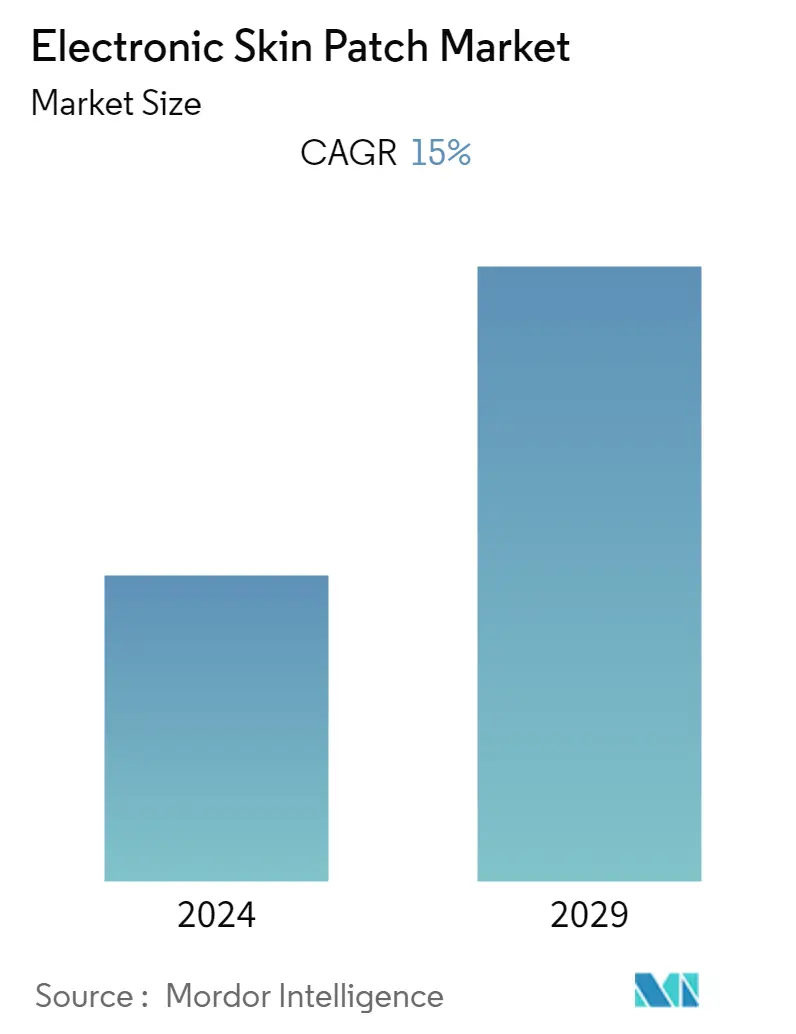Market Size of Electronic Skin Patch Industry

| Study Period | 2019 - 2029 |
| Base Year For Estimation | 2023 |
| CAGR | 15.00 % |
| Fastest Growing Market | Asia Pacific |
| Largest Market | North America |
| Market Concentration | Low |
Major Players
*Disclaimer: Major Players sorted in no particular order |
Electronic Skin Patches Market Analysis
The electronic skin patch market is expected to register a CAGR of 15% and surpass USD 10 billion by the end of the forecast period (2021-2026). The electronic skin patches have started gaining traction among the electronics industry players. The miniaturization of sensors due to technological developments, such as a decrease in chip size from 9nm to 5nm, has been the reason for the development of such products.
- The growing trend for fitness among the population is expected to drive the market positively, during the forecast period. The healthcare industry is expected to benefit from electronic skin patches, as they need an adhesive and do not involve any invasive procedures for monitoring the body vitals.
- The growing initiatives by regulatory bodies, such as FDA's Digital Health Innovation Action plan, which states FDA's approach to ensuring timely access to high-quality, safe, and effective digital health products to its citizens, are expected to boost the market.
- Limited functionality, lack of interoperability, and data security are some of the factors that restrain the adoption of electronic skin patches. However, the digitization initiatives by the governments, coupled with the penetration of new technologies, like IoT, virtual reality, augmented reality, and artificial intelligence, are expected to mitigate such restraining factors.
Electronic Skin Patches Industry Segmentation
The electronic skin patches deploy devices, such as sensors and actuators, directly on to the body, whih gives real-time information about the vitals of a person's body, such as temperature, UV radiation absorption, and oxygen levels in the blood. The report segments the market by application and geography.
| By Application | |
| Cardiovascular Monitoring | |
| Diabetes Management |
| Geography | |
| North America | |
| Europe | |
| Asia-Pacific | |
| Rest of the World |
Electronic Skin Patch Market Size Summary
The electronic skin patch market is experiencing significant growth, driven by advancements in sensor miniaturization and increasing interest from the electronics industry. These patches are gaining popularity in the healthcare sector due to their non-invasive nature and ability to monitor vital signs without the need for traditional, invasive procedures. Regulatory support, such as the FDA's Digital Health Innovation Action plan, is further propelling the market by ensuring the availability of safe and effective digital health products. Despite challenges like limited functionality and data security concerns, the integration of technologies such as IoT, virtual reality, and artificial intelligence is expected to overcome these barriers, enhancing the adoption of electronic skin patches.
In the realm of healthcare applications, electronic skin patches are proving to be invaluable, particularly in cardiovascular monitoring and diabetes management. They offer a non-invasive alternative for tracking cardiac functions, which is crucial for athletes and individuals with heart conditions. Similarly, innovations like the sugarBEAT device are transforming diabetes care by providing continuous glucose monitoring without invasive procedures. The competitive landscape is marked by high rivalry among key players who invest heavily in research and development to maintain their market position. Strategic partnerships and mergers are common as companies strive to expand their market presence and leverage technological advancements to meet the growing demand for electronic skin patches.
Electronic Skin Patch Market Size - Table of Contents
-
1. MARKET DYNAMICS
-
1.1 Market Overview
-
1.2 Introduction to Market Drivers and Restraints
-
1.3 Market Drivers
-
1.3.1 Rising Trend for Fitness among the Consumers
-
1.3.2 RisingDemand for Connected Monitoring Devices
-
-
1.4 Market Restraints
-
1.4.1 Interoperability Issues between New, Existing, and Legacy Systems
-
-
1.5 Industry Value Chain Analysis
-
1.6 Industry Attractiveness - Porter's Five Forces Analysis
-
1.6.1 Threat of New Entrants
-
1.6.2 Bargaining Power of Buyers/Consumers
-
1.6.3 Bargaining Power of Suppliers
-
1.6.4 Threat of Substitute Products
-
1.6.5 Intensity of Competitive Rivalry
-
-
-
2. MARKET SEGMENTATION
-
2.1 By Application
-
2.1.1 Cardiovascular Monitoring
-
2.1.2 Diabetes Management
-
-
2.2 Geography
-
2.2.1 North America
-
2.2.2 Europe
-
2.2.3 Asia-Pacific
-
2.2.4 Rest of the World
-
-
Electronic Skin Patch Market Size FAQs
What is the current Electronic Skin Patch Market size?
The Electronic Skin Patch Market is projected to register a CAGR of 15% during the forecast period (2024-2029)
Who are the key players in Electronic Skin Patch Market?
Vital Connect Inc., Leaf Healthcare Inc., Quad Industries, L'Oréal SA and Sensium Healthcare Ltd are the major companies operating in the Electronic Skin Patch Market.

